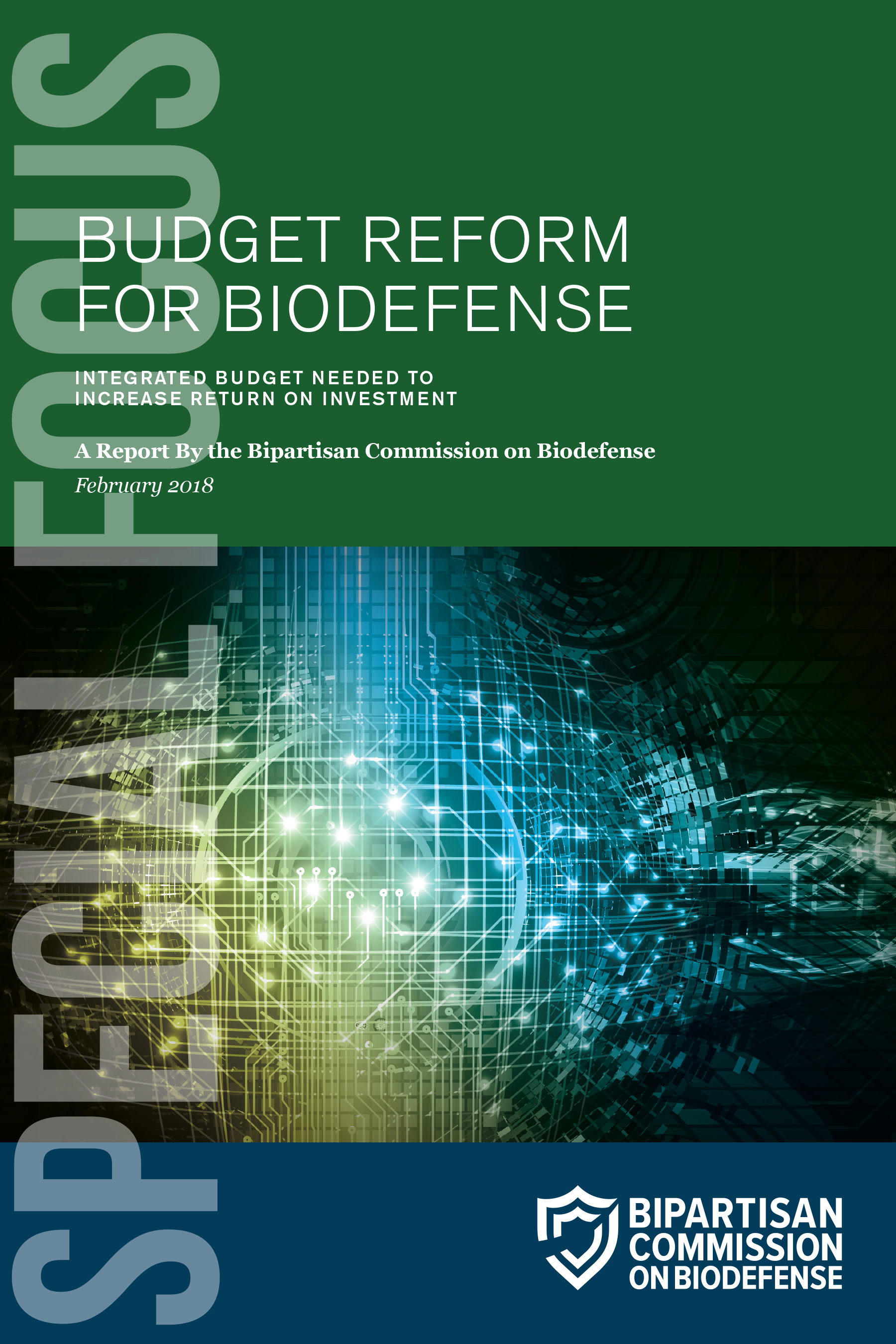Budget Reform for Biodefense
Integrated Budget Needed to Increase Return on Investment
NOTE: The Blue Ribbon Study Panel on Biodefense is now the BIPARTISAN COMMISSION ON BIODEFENSE

- Executive Summary
- Budgetary Status Quo
- Opportunities For Budget Reform
Executive Branch
Legislative Branch
Essential Financial Tools
Biological Disaster Response Funding
- Conclusions
- Acronyms
Commissioners
Joseph I. Lieberman, Chair
Thomas J. Ridge, Chair
Donna E. Shalala
Thomas A. Daschle
James C. Greenwood
Kenneth L. Wainstein
Ex Officio Members
Yonah Alexander, PhD
William B. Karesh, DVM
Rachel Levinson, MA
I. Lewis Libby, JD
Gerald W. Parker, DVM, PhD
George Poste, DVM, PhD, DSc
Tevi Troy, PhD
Commission Staff
Asha M. George, DrPH, Executive Director
Ellen P. Carlin, DVM, Senior Advisor
Robert H. Bradley, Policy Associate
Patty Prasada-Rao, MPH, Panel Coordinator
Patricia de la Sota, Event Coordinator
Acknowledgments
The Commission thanks Hudson Institute for serving as our fiscal sponsor and hosting the Commission’s public meeting on this topic, Budget Reform for Biodefense: Leadership and Coordination. We thank Michelle Mrdeza of MXM Consulting for her advice, expertise, and perspective. We thank Dr. Kavita M. Berger of Gryphon Scientific, David Haun of Grant Thornton, Dr. Monique K. Mansoura and Leslie Platt of The MITRE Corporation, Ben Nicholson, Jeff Schlegelmilch of the National Center for Disaster Preparedness at Columbia University’s Earth Institute, and other anonymous individuals for their insights and comments. We also very much appreciate our Ex Officio members who provided guidance as we developed this report. Finally, the Commission gratefully acknowledges the financial support provided by its donors.
Executive Summary
Biological threats to America and its interests overseas are increasing. Intentionally introduced, accidentally released, and naturally occurring diseases continue to pose a risk to the nation. While we have managed to contain many of these diseases and prevent major losses of life, it is only a short matter of time before a large-scale event exceeds the ability of our country and the world to prevent biological catastrophe.
Myriad federal departments and agencies are responsible for defending against these threats. Referring to their activities as a federal biodefense enterprise suggests a coordinated interagency endeavor unified in achieving common goals, but this is not the reality that exists currently. America is more vulnerable today than it should be to a biological crisis of any scale.
The ultimate success of the recently mandated National Biodefense Strategy depends on the prioritization of the activities it directs and the attachment of funding to those activities. At present, departments and agencies request funding individually, rather than collectively and for mutual benefit. They each negotiate their annual budget requests with the Office of Management and Budget (OMB), which then submits the President’s Budget Request to Congress on a department and agency basis. OMB does not provide an analysis of biodefense spending across the government as part of this submission. Subsequently, multiple congressional subcommittees make funding decisions only for programs within their purview, but without considering overall biodefense spending or mission goals.
Such an integrated budget for biodefense would overcome the opaque, non-strategic spending approach characteristic of the status quo. An integrated budget (and the process needed to develop it) would facilitate coordination and reveal areas that would benefit from interagency funding initiatives and complementary investments. Performance evaluations and evidence-building metrics that accompany the budget would expose areas of effectiveness and ineffectiveness. This information would then support decision makers in making sound fiscal investments, closing capability gaps, and eliminating duplication of effort and resources – all of which would strengthen our national biodefense.
The White House should predicate its vision for long-term investment in biodefense on the National Biodefense Strategy. The Vice President of the United States should provide the leadership needed to facilitate this effort. OMB should develop an integrated biodefense request as part of the President’s Budget Request that includes: (1) a biodefense budget crosscut; (2) performance outcomes for biodefense projects, programs, and activities (PPAs); (3) an analysis of how PPAs contribute to the goals and objectives of the National Biodefense Strategy; and (4) a five-year budget plan.
Congressional leadership should convene a bicameral, bipartisan Biodefense Working Group (BWG) to determine the structures and processes for streamlined and comprehensive biodefense oversight. The BWG should make recommendations to reform congressional authorizations, budget resolutions, and appropriations with regard to all elements of the biodefense enterprise – prevention, deterrence, preparedness, detection, response, attribution, recovery, and mitigation. To stay ahead of the ever-increasing biological threat, Congress should also mandate the establishment of a Future Years Biodefense Budget Program, requiring estimated expenditures and proposed appropriations for at least the current and four succeeding fiscal years.
A cohesive, integrated federal budget request for biodefense would help ensure that decision makers in the Executive and Legislative Branches comprehensively understand existing investments and priorities. Informed by the National Biodefense Strategy, Congress and the White House should take up the following recommendations to strengthen America’s biodefense and use taxpayer dollars wisely.
Leadership and Direction
Development of an integrated biodefense budget begins at the White House with:
- An empowered Vice President who provides political leadership of the biodefense enterprise and helps set major budgetary priorities.
- A dedicated Deputy Assistant to the President for Biodefense within the National Security Council who supports the Vice President and provides day-to-day policy direction and coordination.
- An invested OMB Program Associate Director who provides management and budgetary guidance for biodefense.
- An allied Biodefense Coordination Council that prioritizes interagency biodefense activities and spending.
Budget Development, Evaluation, and Submission
Execution of an integrated biodefense budgeting process continues with:
- Departments and agencies that base requests to OMB on mission requirements.
- OMB examiners who assess the performance and outcomes of federal projects, programs, and activities.
- OMB examiners who evaluate department and agency requests against the National Biodefense Strategy.
- A White House that submits an integrated budget request, a five-year biodefense budget plan, and a budget crosscut to Congress.
Authorization and Appropriation
Culmination of an integrated biodefense budgeting process occurs in Congress with:
- Authorizers who use the National Biodefense Strategy as a benchmark for oversight, and require a Future Years Biodefense Budget Program plan.
- Budget Committees who consider long-term biodefense funding requirements.
- Appropriators who jointly evaluate the President’s Budget Request, coordinate funding priorities across appropriations subcommittees, harmonize spending, and use multi-year funding mechanisms.
- Public-private partnerships in which all parties contribute to the development of viable incentives for research and development.
- A Public Health Emergency Fund composed of no less than $2 billion in no-year money and replenished with regular annual appropriations.
- Sustained U.S. contributions to international programs, including the Global Health Security Agenda.
- A bicameral and bipartisan Biodefense Working Group, temporarily established and empowered to make recommendations to House and Senate Leadership on the most impactful and feasible ways to achieve these goals and objectives.
Copyright © 2018 by the Bipartisan Commission on Biodefense. All rights reserved.
Cover image courtesy of Shutterstock.com.
Bipartisan Commission on Biodefense. Budget Reform for Biodefense: Integrated Budget Needed to Increase Return on Investment. Bipartisan Commission on Biodefense: Washington, DC. February 2018.

